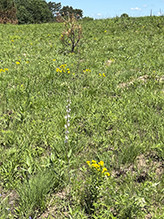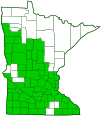prairie larkspur
(Delphinium carolinianum ssp. virescens)
Conservation • Description • Habitat • Ecology • Use • Distribution • Taxonomy
Conservation Status |
|
|||||||
| IUCN Red List | not listed |
|||||||
| NatureServe | NNR - Unranked SNR - Unranked |
|||||||
| Minnesota | not listed |
|||||||
Description |
||
Prairie larkspur is a 20″ to 32″ tall, erect, perennial forb that rises on a group of basal leaves and 1 to 8 stems from fibrous roots. The roots are borne in 2 to 8 spreading bundles (fascicles) that may stretch more or less horizontally up to 32″. They are sometimes stout but they are not tuber-like. The plant does not have a taproot and does not spread by underground stems (rhizomes). A radiating group of 5 to 12 basal leaves forms a rosette rising from the root crown. Basal leaves are rounded to pentagonal in outline, up to 3″ long, and up to 4¼″ wide. They are on slender, up to 5½″ long leaf stalks (petioles). They are deeply palmately divided into 5 to 7 segments. Each segment is further divided into 3 to 29 ultimate lobes. The ultimate lobes are linear to narrowly inversely egg-shaped and 1 ⁄16″ to ⅜″ wide. They may be broadly angled to sharply pointed at the tip, or rounded at the tip with a minute, abrupt, sharp point. The upper and lower surfaces are covered with short, fine, grayish or whitish hairs making them velvety to the touch. The margins are untoothed. Basal leaves wither early but some are present at flowering time. There are 4 to 12 alternate stem leaves above the basal rosette. Stem leaves are smaller, with fewer, narrower ultimate lobes and shorter petioles, but are otherwise similar to basal leaves. They become smaller, less divided, and have shorter petioles as they ascend the stem. Mid-stem leaves have 5 to 15 ultimate lobes, each 1 ⁄32″ to ¼″ wide. Petioles of upper stem leaves are ¼″ to ½″ long. The stems are erect, greenish-white, and round. They are unbranched or sparsely branched just below the inflorescence. They are moderately to densely covered with short, whitish hairs. The inflorescence is a narrow, elongated cluster of 8 to 27 flowers at the end of the central stem, and occasionally 1 or 2 shorter clusters. The cluster is usually unbranched, like a raceme, but is sometimes branched, and is therefore technically a panicle. The axis is moderately to densely covered with short, curled hairs. Individual flowers are on erect flower stalks (pedicels) that appear appressed to the axis, at least in the lower half of the inflorescence. The lowermost pedicels are ½″ to 1 5 ⁄16″long. Each pedicel is subtended by a single, undivided, linear, ⅛″ to ¼″ long, ascending, modified leaf (bract). The bract subtending the lowermost pedicel is sometimes 3-lobed. Each flower is irregularly shaped, about 1″ long, and about ⅝″wide. There are 5 sepals, 4 petals, 25 to 40 stamens, and usually 3, sometimes 4 or 5, pistils. The sepals are petal-like, white or greenish white to pale blue, ⅜″ to 9 ⁄16″ long, and ⅛″ to ¼″ wide. The lateral four sepals are spreading, ⅜″ to 9 ⁄16″ long, and ⅛″ to ¼″ wide. There is a small green or purple patch near the tip of each sepal. The upper sepal is similar but extended backward into a narrow, tube-like appendage (spur). The spur is ⅜″ to 9 ⁄16″ long, ⅛″ to ¼″ wide, and slightly curved upward. The petals are ⅛″ to ¼″ long, free (not fused together), and white, sometimes tinged with blue or yellow. They protrude from the center of the group of sepals. The lower 2 petals are lobed for about half their length and bearded. They more or less cover the stamens. The stamens have yellow to brown anthers on 3 ⁄16″ to ¼″ long filaments. They are not showy. The fruit is a dry, more or less cylinder-shaped, slightly curved, ½″ to ¾″ long seed pod (follicle) with numerous seeds. It has a 1 ⁄32″ to ⅛″ long prolonged tip (beak) and may be covered with fine, short hairs or hairless. They occur in erect clusters of three joined together at the base. The seeds are yellowish-brown or brown to almost black. They appear scaly due to a dense covering of tall, thin, undulating ridges. |
||
Height |
||
20″ to 32″ |
||
Flower Color |
||
White to very pale blue |
||
Similar Species |
||
| This is the only Delphinium in Minnesota. There are no similar species. | ||
Habitat |
||
Dry. Prairies, open woods. Full sun to partial shade. Rocky or sandy soil. |
||
Ecology |
||
Flowering |
||
May to June |
||
Pests and Diseases |
||
|
||
Toxicity |
||
Plants in the genus Delphinium are rich in the alkaloid delphinine, which is toxic to livestock. Deer generally avoid them. |
||
Use |
||
|
||
Distribution |
||||
|
Sources |
|||
| 3/24/2022 | ||||
Nativity |
||||
Native |
||||
Occurrence |
||||
Uncommon |
||||
Taxonomy |
|||
| Kingdom | Plantae (Plants) | ||
| Subkingdom | Pteridobiotina | ||
| Phylum | Tracheophyta (Vascular Plants) | ||
| Class | Magnoliopsida (Dicots) | ||
Order |
Ranunculales (Buttercups, Poppies, and Allies) | ||
Family |
Ranunculaceae (Buttercup) | ||
| Subfamily | Ranunculoideae (Anemones, Buttercups, Larkspurs, and Allies) | ||
| Tribe | Delphinieae | ||
Genus |
Delphinium (larkspurs) | ||
| Species | Delphinium carolinianum (Carolina larkspur) | ||
There are four subspecies of Carolina larkspur. Only ssp. virescens (prairie larkspur) occurs in Minnesota. |
|||
Synonyms |
|||
Delphinium albescens Delphinium carolinianum ssp. penardii Delphinium carolinianum var. virescens Delphinium penardii Delphinium virescens Delphinium virescens var. macroceratilis Delphinium virescens var. penardii Delphinium virescens ssp. penardii |
|||
Common Names |
|||
Carolina larkspur Penard’s larkspur plains larkspur prairie larkspur white larkspur wild larkspur |
|||
Glossary
Bearded
Bearing one or more tufts of hairs.
Bract
Modified leaf at the base of a flower stalk, flower cluster, or inflorescence.
Fascicle
A small bundle or cluster, often sheathed at the base, as with pine needles.
Filament
On plants: The thread-like stalk of a stamen which supports the anther. On Lepidoptera: One of a pair of long, thin, fleshy extensions extending from the thorax, and sometimes also from the abdomen, of a caterpillar.
Follicle
A dry fruit formed from a single carpel, containing many seeds, that opens at maturity along the seed-bearing seam.
Linear
Long, straight, and narrow, with more or less parallel sides, like a blade of grass.
Palmate
Similar to a hand. Having more than three lobes or leaflets that radiate from a single point at the base of the leaf.
Panicle
A pyramidal inflorescence with a main stem and branches. Flowers on the lower, longer branches mature earlier than those on the shorter, upper ones.
Pedicel
On plants: the stalk of a single flower in a cluster of flowers. On insects: the second segment of the antennae. On Hymenoptera and Araneae: the narrow stalk connecting the thorax to the abdomen: the preferred term is petiole.
Petiole
On plants: The stalk of a leaf blade or a compound leaf that attaches it to the stem. On ants and wasps: The constricted first one or two segments of the rear part of the body.
Raceme
An unbranched, elongated inflorescence with stalked flowers. The flowers mature from the bottom up.
Rhizome
A horizontal, usually underground stem. It serves as a reproductive structure, producing roots below and shoots above at the nodes.
Rosette
A radiating group or cluster of leaves usually on or close to the ground.
Sepal
An outer floral leaf, usually green but sometimes colored, at the base of a flower.
Spur
On flowers: a hollow tubular appendage, often containing nectar, formed from a sepal or petal. On branches: a short shoot bearing leaves or flowers and fruit.
Visitor Photos |
|||||
Share your photo of this plant. |
|||||
| This button not working for you? Simply email us at info@MinnesotaSeasons.com. Attach one or more photos and, if you like, a caption. |
|||||
Nancy Falkum |
|||||
Prairie Larkspur and puccoon at TNC Cox Unit |
|||||
 |
|||||
 |
|||||
Kevin Erickson |
|||||
It volunteered in my lawn. |
|||||
 |
|||||
MinnesotaSeasons.com Photos |
|||||
Plant |
|||||
 |
 |
||||
Inflorescence |
|||||
 |
 |
||||
Flowers |
|||||
 |
 |
||||

Slideshows |
||

Visitor Videos |
|||
Share your video of this plant. |
|||
| This button not working for you? Simply email us at info@MinnesotaSeasons.com. Attach a video, a YouTube link, or a cloud storage link. |
|||
Other Videos |
|||
| Prairie Larkspur Perry Brewer |
|||
About
Uploaded on Jul 22, 2009 Summary of the effects and how to identify Prairie Larkspur. |
|||
| Prairie Larkspur. CSUExtension |
|||
About
Uploaded on Jul 12, 2011 Michael Fisher, Area Extension Livestock Agent in Colorado discusses the effects and identification of prairie larkspur. |
|||


|
Created: Last Updated: © MinnesotaSeasons.com. All rights reserved. |



